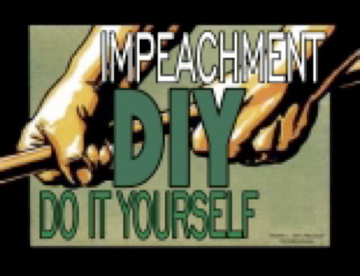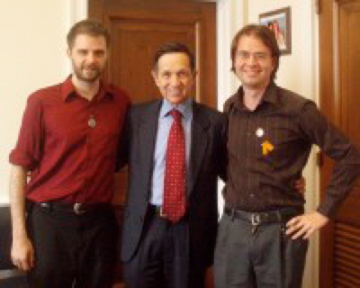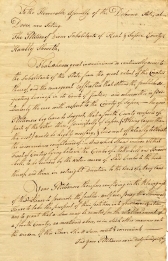
Impeach Bush/Cheney:
| Do-It-Yourself Impeachment... |
|
 Impeach for Peace met with Rep. Dennis Kucinich in July of '07, and Kucinich then made the decision to enter the names of those who submit the Do-It-Yourself Impeachment into the congressional record! Last year, Impeach for Peace researched a method for impeaching the President or Vice President using a little known and rarely used part of the Rules of the House of Representatives ("Jefferson’s Manual"). This document actually empowers individual citizens to initiate the impeachment process themselves. Impeach for Peace met with Rep. Dennis Kucinich in July of '07, and Kucinich then made the decision to enter the names of those who submit the Do-It-Yourself Impeachment into the congressional record! Last year, Impeach for Peace researched a method for impeaching the President or Vice President using a little known and rarely used part of the Rules of the House of Representatives ("Jefferson’s Manual"). This document actually empowers individual citizens to initiate the impeachment process themselves.DOWNLOAD THE DOCUMENT Assist Kucinich in his effort to Impeach Bush. "Jefferson's Manual" is an interpretive guide to parliamentary procedure, and is included (along with the Constitution) in the bound volumes of the Rules of the House of Representatives. It is ratified by each congress (including the current one), and has been updated continuously through the history of our democracy. The section covering impeachment lists the acceptable vehicles for bringing impeachment motions to the floor of the House. |
Kucinich Speaking About Impeachment |
 Before the House Judiciary Committee can put together the Articles of Impeachment, someone must initiate the impeachment procedure. Most often, this occurs when members of the House pass a resolution. Another method outlined in the manual, however, is for individual citizens to submit a memorial for impeachment.
After learning this information, Minnesotan and Before the House Judiciary Committee can put together the Articles of Impeachment, someone must initiate the impeachment procedure. Most often, this occurs when members of the House pass a resolution. Another method outlined in the manual, however, is for individual citizens to submit a memorial for impeachment.
After learning this information, Minnesotan andImpeach for Peace member (Jodin Morey) found precedent in an 1826 memorial by Luke Edward Lawless which had been successful in initiating the impeachment of Federal Judge James H. Peck. Impeach for Peace then used this as a template for their "Do-It-Yourself Impeachment." Now any citizen can download the DIY Impeachment Memorial and submit it, making it possible for Americans to do what our representatives have been unwilling to do. The idea is for so many people to submit the Memorial that it cannot be ignored. DOWNLOAD THE DOCUMENT Download, fill in your relevant information in the blanks (name, State, notary is optional), and send in a letter today. We're sending this wave in to House Rep. Dennis Kucinich who has recently spoken in favor of impeachment. There's also extra credit for sending a DIY Impeachment to your own representative as well as representatives reccommended by Keith Ellison of the House Judiciary. One of the copies will come to Impeach for Peace's home office and we'll hand deliver them to a House Rep. with cameras rolling. That's right — to make a big impact, when we get enough, we'll deliver them all on the same date (In previous waves, we've had over 500,000 download of the document representing over 1.7 million mailings). We hope to flood the congress with sacks of mail and cause a newsworthy event to further pressure them to act on the memorials. Although, it's important to keep in mind that in the 1830 precedent, impeachment resulted as a result of a single memorial. Yours might be the one. DOWNLOAD THE DOCUMENT < |
| (trouble downloading?) | |
Frequently asked Questions and Answers
Concerns over the strategy of pushing for impeachment in this way?
See the 'Arguments Against Impeachment' at the bottom of the main page.
In the News: KFAI radio interview, "Mike Malloy Show," and Peter Werbe audio.
EMAIL ALL YOUR FRIENDS ABOUT THIS!!
We would especially like to thank ImpeachBush.tv for their support, and whose charges related to impeachment we used in the creation of this document.
Also, if you're interested:
Information regarding Impeachment procedure
Precedent: Judge Peck's Impeachment supplied by the U.S. House of Representatives and policyreview.org.
House rules that allow for the submission of the memorial

Jefferson's Manual
Jefferson's Manual is a sort of interpretive guide to parliamentary procedure, and is included (along with the Constitution) in the bound volumes of the Rules of the House of Representatives. It is ratified by each congress (including the current one), and has been updated continuously through the history of our democracy.Within the Manual itself, the section covering impeachment is designated Section LIII. Section 603 refers to the section of the entire volume (including the Constitution and Rules) in which you'll find the listing of acceptable vehicles for bringing impeachment motions to the floor. The second vehicle being of most interest to our method. It reads:
|
"In the House of Representatives there are various methods of setting an impeachment in motion: by charges made on the floor on the responsibility of a Member or Delegate (II, 1303; III, 2342, 2400, 2469; VI, 525, 526, 528, 535, 536); by charges preferred by a memorial, which is usually referred to a committee for examination (III, 2364, 2491, 2494, 2496, 2499, 2515; VI, 552); or by a resolution dropped in the hopper by a Member and referred to a committee (April 15, 1970, p. 11941-2); by a message from the President (III, 2294, 2319; VI, 498); by charges transmitted from the legislature of a State (III, 2469) or Territory (III, 2487) or from a grand jury (III, 2488); or from facts developed and reported by an investigating committee of the House (III, 2399, 2444)."
|
Memorial: "a written statement of facts accompanying a petition presented to somebody in authority"
Preferred: "to make a charge against somebody by submitting details of the alleged offense to a court, magistrate, or judge for examination, or prosecute such a charge"
from the Encarta® World English Dictionary
Source: U.S. Government Printing Office
Precedents:
Hinds - III, 2364, 2491, 2494, 2496, 2499, 2515
Cannon's - VI, 552

Peck and contempt (care of policyreview.org)
There is the case of Judge James H. Peck, an 1830-31 impeachment and acquittal. President Monroe had appointed Peck to the bench in 1822. In 1828, the Democrats swept to power. That met the condition for partisan conflict.
Peck was judge in Missouri in a series of land claim cases in the territory of the Louisiana purchase. The law was complicated, the interests involved huge. In the first such case, in 1825 (the account here draws mainly on Bushnell’s in Crimes, Follies, and Misfortunes), Peck ruled against the client of a lawyer named Luke Edward Lawless. Because of the high degree of interest in the case, Peck published his ruling in a St. Louis newspaper in 1826. Shortly thereafter, a detailed rebuttal of Peck’s ruling appeared in another newspaper under the byline, "A Citizen." Peck was furious at the attack. He believed the "Citizen" rebuttal, in addition to its flawed legal reasoning, was replete with errors and misrepresentations of his ruling. Lawless’s authorship soon became known.
Bushnell writes:
Peck held the letter to be a contempt of court, sentenced Lawless to twenty-four hours in jail, and suspended him from practicing in federal court for eighteen months [a serious blow to Lawless’s livelihood as a lawyer specializing in land claims before the federal courts]. As the basis of the contempt ruling, Peck found that Lawless acted "with intent to impair the public confidence in the upright intentions of said court, and to bring odium upon the court, and especially with intent to impress the public mind, and particularly many litigants in this court, that they are not to expect justice in the cases now pending therein."
Lawless felt he was entirely within his rights to criticize a published decision and saw the contempt ruling as a tyrannical affront to the Constitution. He began a long crusade against Peck that ultimately led to impeachment nearly five years later on one article dealing solely with the judge’s treatment of Lawless. The article accused Peck of acting "to the great disparagement of public justice, the abuse of judicial authority, and to the subversion of the liberties of the people of the United States." James Buchanan, who went on to be elected president in 1856, was chairman of the House managers.
Peck maintained that his contempt ruling was within his powers as a judge, and his defenders argued that even if it went too far, Peck did not, as the article alleged, act with bad intent, believing that he possessed sufficient authority for his actions. At a minimum, however, it seems fair to say that Peck’s actions from the bench were harsh enough to meet the test of genuinely dubious conduct.
Peck was acquitted with 21 votes in favor of removal and 22 against. Where was the abuse of the separation of powers here? In this case, not in the statute books but in the common law — the precedents Peck relied on to hold Lawless in contempt and to sentence him harshly. As Bushnell observes, Peck’s defenders "sought to refute the charge of abuse of the contempt power by citing English and American precedents supporting the authority of courts to punish for contempts like Lawless’s." The House tried to hold his conduct to the standard of its more circumscribed view of judicial contempt powers. The Senate was not willing to rely on the House’s assertions to the extent necessary to remove Peck.
But the Senate, like the House, can hardly be said to have found Peck’s conduct salutary. Both chambers amply demonstrated this by approving, within a month of Peck’s acquittal, legislation introduced by Buchanan restricting contempt findings in federal courts roughly along the lines of the terms the House managers had unsuccessfully tried to apply in Peck’s impeachment. Contempt could be found in misbehavior in a courtroom or close enough to it to disturb its proceedings; or in misbehavior in such business of the courts’ as filing motions and briefs; or in the failure to obey a lawful court order. It could not be found in a newspaper rebuttal to a court’s decision. Buchanan’s legislation governs contempts in federal courts to this day.
Lawless' actual memorial: Source-U.S. House Precendents: Hinds III, 2496-2499
More information on Peck's impeachment; Carnegie Mellon University Universal Library

Petitions, memorials, and private bills
[110th Congress House Rules Manual -- House Document No. 108-241][From the U.S. Government Printing Office Online Database]
Petitions, memorials, and other papers addressed to the House may be presented by the Speaker as well as by a Member (IV, 3312). Petitions from the country at large are presented by the Speaker in the manner prescribed by the rule (III, 2030; IV, 3318; VII, 1025). A Member may present a petition from the people of a State other than his own (IV, 3315, 3316). The House itself may refer one portion of a petition to one committee and another portion to another committee (IV, 3359, 3360), but ordinarily the reference of a petition does not come before the House itself. A committee may receive a petition only through the House (IV, 4557).
Source: U.S. Government Printing Office
"I just want you to know that, when we talk about war, we're really talking about peace."
Bush, June 18, 2002
"War is Peace"
Big Brother in George Orwell's 1984

Contact Us! © 2006 ImpeachForPeace.org

